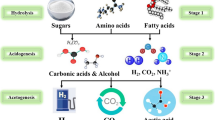Abstract
The suitability of differentGracilaria spp. and twoSargassum species for bioconversion to methane was determined through bioassays of methane yield.Gracilaria species and strains were excellent feedstocks for high methane yields, ranging from 0.28 to 0.40 m3 kg−1 volatile solids added. These yields ranged from 58 to 95% of theoretical stoichiometric yields. Methane yields were highly correlated with acid soluble carbohydrate components of theGracilaria spp. BothSargassum fluitans andS. pteropleuron were poor feedstocks, with methane yields ranging from 0.12 to 0.19 m3 kg−1 volatile solids added, 27 to 46% of theoretical stoichiometric yields, respectively. The various tissue types of theseSargassum species were also poor feedstocks for anaerobic digestion to methane. While there is no clear explanation for the low methane yields, the twoSargassum spp. appear to contain a high proportion of an insoluble, non-extractable component which may not be available as a substrate for bioconversion to methane.
Similar content being viewed by others
References
Bird KT (1989) Intensive seaweed cultivation. Aquaculture Magazine 15 (6): 29–35.
Bird KT (1987) Tropical macroalgal cultivation for bioconversion to methane. Energy from Biomass and Waste X: 1283–1292. Institute of Gas Technology, Chicago, IL.
Bird KT, Ryther JH (In press) Cultivation ofGracilaria verrucosa strain G-16 for agar. Hydrobiologia.
Bird KT, Habig C, DeBusk T (1982) Nitrogen allocation and storage patterns inGracilaria tikvahiae (Rhodophyta). J. Phycol. 18: 344–348.
Bird KT, Hanisak MD, Ryther J (1981a) Chemical quality and production of agars extracted fromGracilaria tikvahiae grown in different nitrogen enrichment conditions. Bot. Mar. 24: 441–444.
Bird KT, Hanisak MD, Ryther J (1981b) Changes in agar and other chemical constituents of the seaweedGracilaria tikvahiae when used as a substrate in methane digesters. Resources and Conservation 6: 321–327.
Cheshire AC, Hallam ND (1985) The environmental role of alginates inDurvillaea potatorum (Fucales, Phaeophyta). Phycologia 24: 147–153.
Chynoweth DP, Fannin KF, Srivastava VJ (1987) Biological gasification of marine algae. In: Bird KT, Benson PH (eds), Seaweed Cultivation for Renewable Resources. Elsevier Press, Amsterdam, 285–304.
Chynoweth DP, Ghosh S, Klass DL (1981) Anaerobic digestion of kelp. In: Sofer S, Zaborsky O (eds), Biomass Conversion Processes for Energy. Plenum Press, NY, 315–338.
Cote GL, Hanisak MD (1986) Production and properties of native agars fromGracilaria tikvahiae and other red algae. Botanica Marina 29: 359–366.
Daly Jr, EL, Prince JS (1981) The ecology ofSargassum pteropleuron Grunow (Phaeophyceae, Fucales) in the waters of South Florida III. Seasonal variation in alginic acid concentration. Phycologia 20: 352–357.
Dawes CJ, Bird KT, Hanisak MD (1988) Physiological responses of transplanted populations ofSargassum pteropleuron Grunow in Florida. Aquatic Botany 31: 107–123.
Fannin KF, Srivastava VJ, Chynoweth DP, Bird KT (1983) Effects of the interaction between biomass composition and reactor design on anaerobic digestion process performance. Energy from Biomass and Waste VII: 563–584. Institute of Gas Technology, Chicago, IL.
Habig C, Ryther JH (1984) Some correlations between substrate compositions and biogas yields. Energy from Biomass and Waste VIII: 817–832. Institute of Gas Technology, Chicago, IL.
Jerger DE, Chynoweth DP (1987) Anaerobic digestion of biomass. Biomass 14: 99–113.
Larsen B (1978) Brown seaweeds: Analysis of ash, fiber, iodine and mannitol. In: Hellebust JA, Craigie JS (eds), Handbook of Phycological Methods, Physiological and Biochemical Methods. Cambridge Univ. Press, Cambridge, 181–188.
Owen WF, Stuckey DC, Healy JB, Young LY, McCarthy PL (1979) Bioassay for monitoring biochemical methane potential and anaerobic toxicity. Wat Res. 13: 485–492.
Prince JS, Daly Jr, EL (1981) The ecology ofSargassum pteropleuron Grunow (Phaeophyceae, Fucales) in the waters off south Florida. IV. Seasonal variation in mannitol, protein, ash and laminarin. Phycologia, 20: 232–241.
Selby HH, Wynne WH (1973) Agar. In: Whistler RL (ed.), Industrial Gums, Polysaccharides and Their Derivatives. Academic Press, NY, 29–48.
Tompkins A (1982) Marine Biomass Program, 1982 Annual Report. Gas Research Institute Annual Report, Gas Research Institute, Chicago, IL.
Author information
Authors and Affiliations
Rights and permissions
About this article
Cite this article
Bird, K.T., Chynoweth, D.P. & Jerger, D.E. Effects of marine algal proximate composition on methane yields. J Appl Phycol 2, 207–213 (1990). https://doi.org/10.1007/BF02179777
Received:
Accepted:
Issue Date:
DOI: https://doi.org/10.1007/BF02179777




